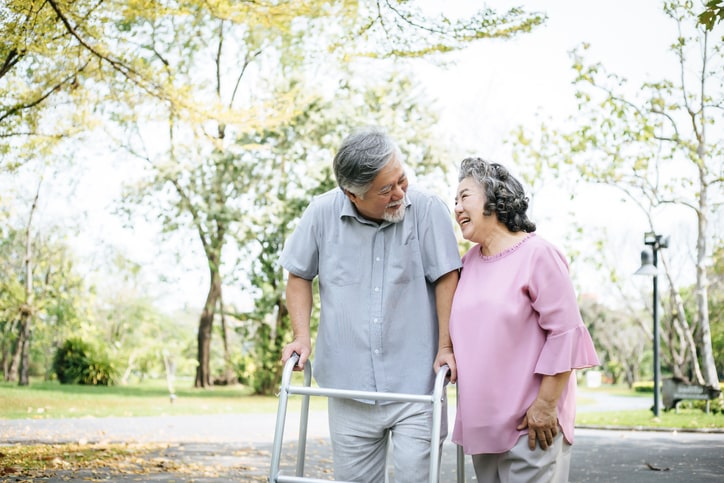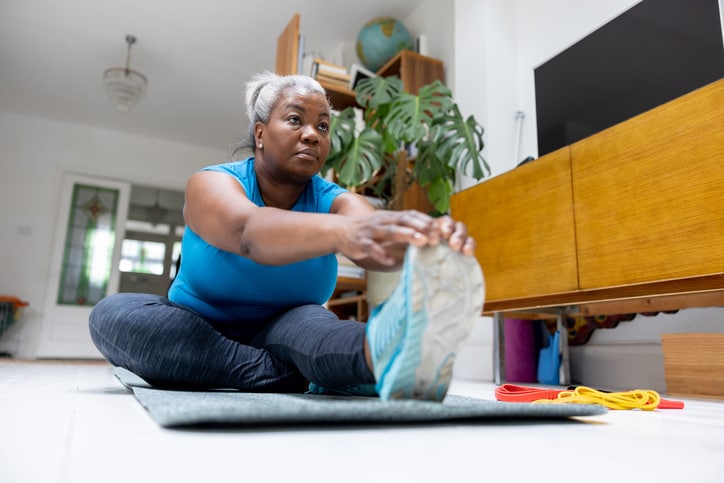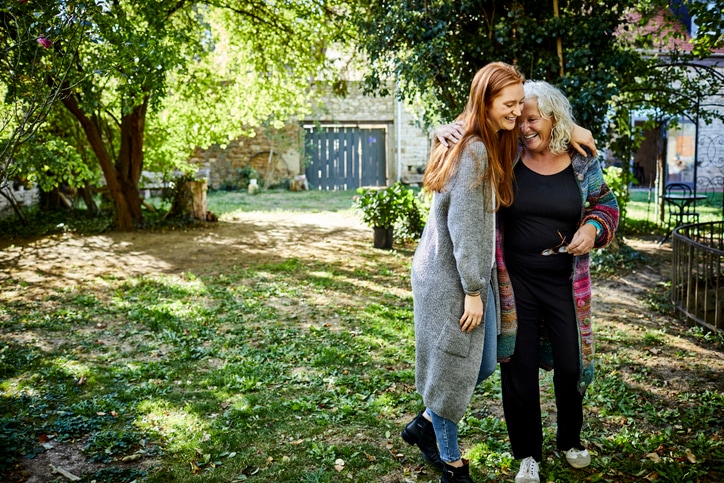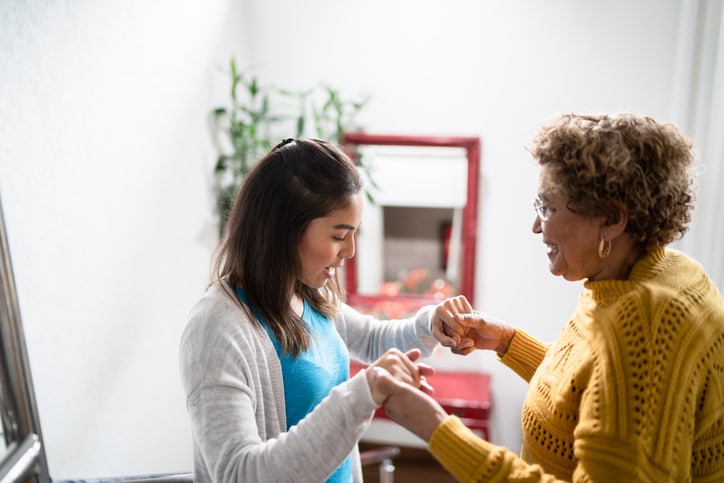The benefits of physical activity are indisputable. Countless studies have shown links between exercise and longevity, mood and overall health. But for older adults with limited mobility, it’s not as simple as going out for a jog or taking a beloved yoga class. “Physical activity can look different for different people,” says Caroline Morris, a board certified clinical specialist in geriatric physical therapy and owner of Morris Clinic in Alexandria, Virginia. “For some older adults, getting from the bed to a chair can be a high-intensity activity. Others may need to do weight training or a brisk walk to achieve the same level of intensity.”
But regardless of one’s ability level, physical activity is crucial for seniors — perhaps even more so for those with limited mobility.
“All older adults benefit from physical activity because it is protective and beneficial for their physical, cognitive and mental health,” says Dr. Nina Blachman, a geriatrician and assistant professor of medicine at NYU Langone Health. “It is important for older people with limited mobility to stay active to prevent further physical decline and dependence.”
“All older adults benefit from physical activity because it is protective and beneficial for their physical, cognitive and mental health.”
— DR. NINA BLACHMAN, GERIATRICIAN
Looking for ideas to get seniors with limited mobility moving? Here are expert-backed ideas.
Indoor exercises and activities for older adults with limited mobility
Blachman notes that older adults have varying degrees of physical limitations, so while “some may be able to do yoga or stationary biking, others may benefit from chair exercises.” Either way, she says, older adults “should aim to exercise 30 minutes per day, and these 30 minutes do not need to be consecutive.”
Here are some indoor exercises and activities to try:
Commercial breaks
One of the simplest activities seniors with limited mobility can do is to get up at least every 30 minutes and move a bit. “When people sit for an extended period without getting up, their nerves, muscles and bones tend to weaken,” explains Preston Brown, a board certified clinical specialist in geriatric physical therapy and owner of Prestige Therapy and Wellness in Waukesha, WI. “This weakness may lead to increased difficulty to do daily activities like getting out of chairs, doing steps or walking around stores.”
“Older adults with limited mobility should try to get up or change positions at least every half hour from sitting, especially if they’re watching TV,” Brown continues. “They can get a break from the commercials and take a few laps around the house, or if the weather is decent, around their home. Getting up every 30 minutes can limit stiffness and improve the blood flow that our bodies need to stay active.”
Brown notes that it’s important for older adults with limited mobility to plan a few activities they can perform on their feet throughout the day. A few simple ones he suggests:
- Light housework
- Walking
- Dancing
- Getting out of the chair and standing in place
“Older adults with limited mobility should try to get up or change positions at least every half hour from sitting, especially if they’re watching TV.”
— PRESTON BROWN, A BOARD CERTIFIED CLINICAL SPECIALIST IN GERIATRIC PHYSICAL THERAPY
Sit to stand
According to Morris, sit to stand — which is simply sitting in a chair and standing up — is probably the most important exercise for maintaining functional independence across the lifespan. “If you only do one exercise, this should be it,” she says.
“If the goal is to maintain or improve ability to get in and out of a chair, this exercise should be completed daily, a few reps at a time,” Morris says. If the goal is to build muscle mass in the lower body, the exercise should be completed as follows:
- Reps: Go until fatigued or form starts to break down (volitional fatigue)
- Sets: Two to three
- Days per week: Two to three, nonconsecutive
To do sit to stand, Morris advises using a sturdy armchair positioned against a wall. “Stand up and sit down, making sure not to plop on the way down,” she says. “For folks who aren’t able to do this independently, an extra cushion or folded blanket can be added to the seat of the chair.”
Sit to stand continuum
There are a few variations that can be put on sit to stand. Here are two, according to Morris:
- Seated forward weight shift. “While seated in a chair, shift your trunk forward so that you feel more pressure in your feet and less pressure in your tailbone and sits bones,” she explains. “Arms can be on the armrests, or for more challenge, crossed over your chest or outstretched in front.”
- Sit to stand without arms. “Stand up and sit down without pushing through your arms,” Morris says. “Arms can be crossed over your chest or outstretched in front. If you are unable to do this independently, add an extra cushion or folded blanket to the seat of the chair.”
Squats
Like sit to stand, squats are a simple activity that can build strength and facilitate intermittent movement. Here are two of Morris’s favorite variations for folks with limited mobility:
- Mini squats. Start in a standing position and imagine you are sitting down into a chair. Lower your hips a few inches and return to the standing position. Your knees should not pass forward over your toes. You can do these mini squats in front of a chair or similar surface for safety.
- Full squats. Start in a standing position and imagine you are sitting down into a chair. Lower your hips as low as you can without losing your balance and return to the standing position. Your knees should not pass forward over your toes. You can do these full squats in front of a chair or similar surface for safety.
Kitchen counter exercises
To help older adults stay steady on their feet, Brown suggests doing kitchen counter exercises, which build muscle while offering support. “The kitchen counter is a safe and effective way to get muscles strong,” he says. “Muscle-building exercises at the kitchen counter can help improve your leg strength and balance.”
Here are a few simple variations to try:
“Muscle-building exercises at the kitchen counter can help improve your leg strength and balance.”
— PRESTON BROWN
Breathing exercises
Breathing exercises are a simple, stress-busting activity that Morris recommends to clients of every ability level. “Breathing exercises are available for everyone and have benefits for improving lung capacity and reducing stress,” she says, adding that one of her favorites is belly breathing. Here, she explains how to do it:
- Place one hand on your belly and one on your chest.
- As you breathe in, direct the air to your belly so you feel your hand rise.
- As you breathe out, pull the belly towards the spine.
“The hand on the belly should move more than the hand one the chest,” she notes. “Once you get the technique down, work on lengthening your exhale, so that it eventually becomes twice as long as your inhale.” For best results, do for a few minutes daily.
Outdoor exercises and activities for older adults with limited mobility
When the weather is cooperating, older adults should consider taking things outdoors, where they’ll get both the benefits of movement and the benefits of being outside. Here are a few senior outdoor activities to try:
Walking
Blachman, Brown and Morris all agree: Walking is one of, if not, the best outdoor activities for seniors. However, there are a few things older adults with limited mobility should consider.
- Use an assistive device, if need be. “For older adults who use a walking aid, be sure to bring that along,” notes Brown.
- Start where you are and go up from there. “Increase your distance or time walking by 10% each week,” Morris says. “Eventually, try to build up to 150 minutes per week, which could be five 30-minute walks or three 50-minute walks.”
- Follow doctor’s orders. “Walking for slightly longer distances than normal is one of the best ways to build more energy, strength and endurance and keep your mind sharp,” says Brown. “But make sure you exercise caution and limit your distance appropriately if your healthcare provider has instructed you to do so.”
Take walking up a notch
For seniors looking to get more bang for their buck with walking, Morris recommends the following:
- Try uneven surfaces. “Walking over uneven surfaces, like a bumpy sidewalk, a lawn or a trail, challenges balance and has more benefits for bone density than walking on flat surfaces,” she says.
- Walk with a group. “Joining a walking group adds a social component to the physical activity, which engages more parts of your brain.”
Tai Chi
“Tai Chi is a great activity for adults with limited mobility that can be done outdoors,” says Blachman, who adds that it can really “help with balance.” One 2019 study found that Tai Chi also promotes emotional stability and slows “gray matter atrophy” in older adults.
Blachman encourages trying to clock in about 30 minutes of physical activity a day, but this six-minute beginner Tai Chi video is a good jumping off point:
Just get out
While exercises and activities are great for getting stronger and increasing stamina, simply getting out of the house can be extremely beneficial, as well. A 2017 study found that in adults aged 70-90 “leaving the house daily was associated with lower mortality risk, independent of social, functional, or medical status.”
“In addition to walking, outdoor activities that can help seniors with limited mobility stay active can be as simple as going for a car ride, walking around the grocery store, going to church or heading to the local senior center to participate in social activities,” says Brown. “And it’s even better for the body and mind if these things are done consistently on a schedule.”
The importance of physical activity for older adults
According to Morris, when older adults regularly engage in physical activities they benefit from following:
- Improved muscle strength.
- Improved bone density.
- Endurance.
- Better balance.
- More flexibility.
- Better posture.
- A higher overall quality of life.
“Physical activity is key to participating in life and preventing declines in health, no matter your mobility level,” she adds. “For the best results, it’s important to engage daily, but remember that something is better than nothing.”




